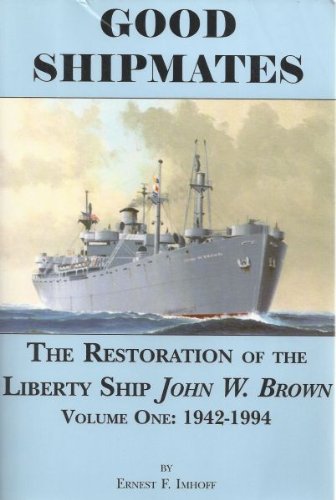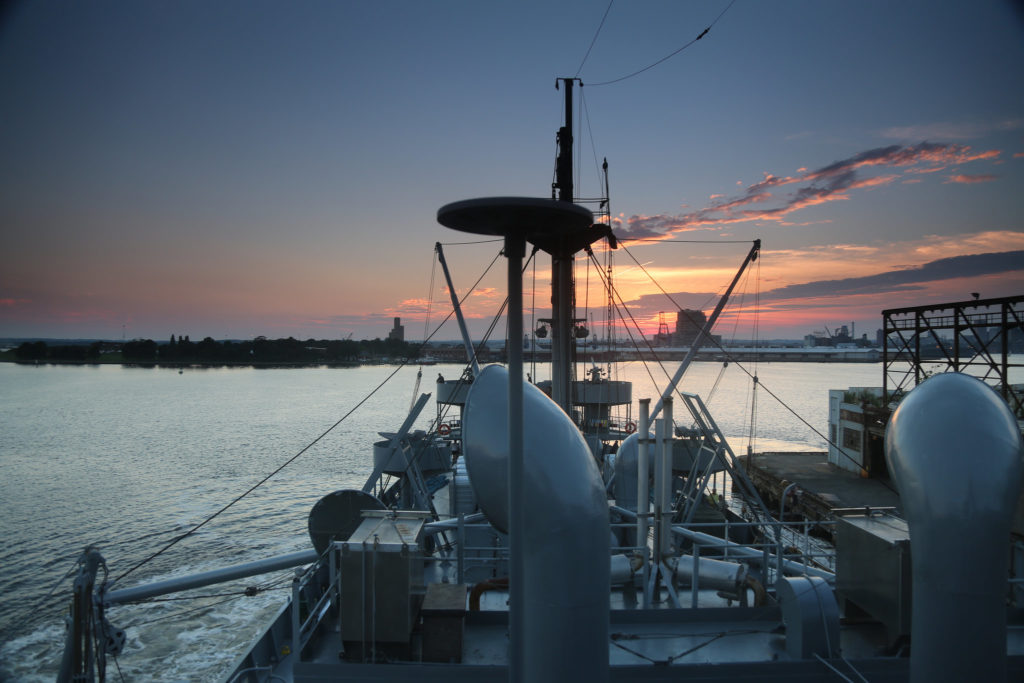Remembering Ernie Imhoff
The other night, reading in my bunk by the glare of a drop light, I came across something curious in American Sea Writing: A Literary Anthology, published in 2000 by the Library of America. The information, new to me, addressed two ardent, entwined passions: the written word and the bounding main. It came from a story by the celebrated New Yorker writer Joseph Mitchell (1908-1996) called The Bottom of the Harbor, the title essay of the author’s 1959 collection of Gotham maritime tales.
Wrote Mitchell of the mossbunker, better known as menhaden, “[It’s] a factory fish; it is converted into an oil that is used…[in] printing inks, which is why some newspapers have a fishy smell on damp days.” (So, the news is fishy even before the guy at Lexington Market wraps it around your rockfish!)
It reminded me of my friend and longtime newspaper colleague Ernie Imhoff, who died this past December at age 84. Alongside the sea anthology lay Good Shipmates, Imhoff’s detailed account of the restoration of the SS John W. Brown Liberty ship. At the front of the book, Imhoff writes of crossing the Atlantic after college in 1958 on the SS Groote Beer and the spell cast by “a dome of the sky showed a wider blueness by day and brighter Milky Way at night. The sea changed color—dark blue, green, black, white or gray. The salty wind was exhilarating.”

Such prose, worthy of Mitchell, made me wish Ernie had never become an editor. Much beloved by those he worked with for 40 years at The Evening Sun on Calvert Street in Baltimore, Imhoff joined the paper in the autumn of 1963, covering the space program. One of his last assignments before being named city editor at the paper of Mencken and Schoettler was the Apollo 11 moon landing in 1969.
In the wake of the big shots’ decision to bury the paper, Imhoff served as the last managing editor of The Evening Sun in 1995. The staff merged with the morning paper and Ernie worked as the paper’s ombudsmen. One of his columns was headlined “We Fix Misteaks.” He retired in 1999 after filing more than 2,000 bylines: Ernest F. Imhoff. The statistic is as close to accurate as possible because Ernie was an obsessive counter of all he did.
“My father counted everything,” said Jennifer Imhoff Foley of Bowdoinham, Maine. “He counted how many banana breads he made for friends and family, every lap he swam in the pool, every step he ran up and down in Bolton Hill” where he and his wife Hilda Klingaman raised their family.
He also covered opera and nonprofits after the demise of The Evening Sun. One of the latter was Project Liberty Ship, the now 44-year campaign to resuscitate and sustain the Brown. Imhoff was smitten, volunteered and earned his ordinary seaman’s papers from the Coast Guard. “He wanted his connection to the Brown to be authentic,” said his son Peter Imhoff of Baltimore.
Ernie wrote that the Brown was “hustled together” in 56 days and launched on September 7, 1942 from Bethlehem Steel’s Fairfield yard. Identical to 2,710 other Liberty Ships that supplied troops and supplies to the Allies during World War II, she is one of two that remain operational. (The other is the SS Jeremiah O’Brien, which docks in San Francisco.)
The first Liberty Ship to slide down the rails was the SS Patrick Henry, scrapped the year Ernie graduated from Williams College with a degree in German literature. The last one built, the SS Albert M. Boe, is a fish cannery docked in Kodiak, Alaska. Another was named for Harriet Tubman. The SS John W. Brown is currently docked on the Canton waterfront. “It lives today,” wrote Imhoff. “The fancy Cunard Queens never last nearly so long.”

“As much as Dad loved journalism, he never wanted the end of his career to be the end of his working life. He always had to have one more thing going on.” said Foley, who took her sons on the Brown one afternoon for a trip to the Chesapeake Bay Bridge and back. The ship began steaming under her own power again—for the first time in 45 years—in 1991.
Added Peter, “My father’s fascination with the Brown stemmed from his love of adventure, his love of history, and his interest in telling the stories of people’s lives. As far back as I can remember, he was transfixed by stories of people battling the elements—mountains, weather, or seas.” An adept climber, Imhoff summited 65 mountains of 4,000 feet or more across New England, particularly throughout the Berkshires around his childhood home of Williamstown, Massachusetts. At the top of each, he rewarded himself with a tin of sardines.
Brian Hope, a retired Chesapeake Bay pilot and artist, was the first chairman of Project Liberty Ship. Hope put together the team that towed the Brown to Baltimore in 1983 from the James River “dead fleet” in Virginia and painted the image of the ship that graces the cover of Imhoff’s book. Asked if Ernie was a natural seaman, the 78-year-old captain said, “He was a natural talker.”
The comment isn’t a slight. Ernie’s documentarian skills served the Brown as well, or better, than his ability to handle lines. Good Shipmates is a Studs Terkel-worthy oral history of dozens of men who served in World War II and united in salvaging the vessel. “Ernie made a determined effort to interview and get stories from all of the crew members,” said Hope. “There weren’t many he missed.”
Some 16 million American men and women served their country during World War II. About 300,000 of them remain, most between the ages of 90 and 100, with more than 350 passing away each day.
While chipping rust or painting a bulkhead side-by-side with one of the old salts who brought the Brown back to life, Ernie became fascinated with their lives and their stories, catching up with them in the crew mess over coffee, “tilting his head to the right and start taking notes,” said Foley of her father’s style. “He was a good listener,” said Peter. “People trusted him with their stories.”
The ancient verity is that once you’re dead, you can’t take it with you. But that’s not entirely true. When people die, they take their stories with them, never again to be asked, “Hey, remember that time?” It’s worse than a library burning down; there are no copies.




